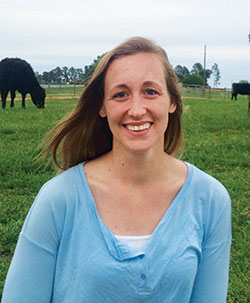Rules are made to be broken |
| By Paige Smart |
|
|
|
The author is a partner in a custom stocker cattle operation in eastern North Carolina. She holds a master’s degree in animal science from North Carolina State University.  Paige Smart Don’t get me wrong, the following rules are a great starting point for everyday management decisions. The mistake is in calling any stray from these rules wrong. Instead, we must understand the purpose of these rules and evaluate if there is a short-term need to break them. Let’s examine some common forage rules, their intent, and when it’s reasonable to violate them. Take half, leave half (THLH): This rule has some great takeaways. Its intent is to help the forage manager understand that leaving behind residual grass is a positive thing. With the good soil coverage that comes with “Take half, leave half,” you’ll have faster regrowth periods, reduced water runoff, and a stronger root structure for drought resilience. This rule opens our eyes to the benefits of managing forages for longevity, and it also draws attention to the living fraction of the soil that can benefit from that residual. However, THLH is often an oversimplification. Each forage species has a range from when we can safely begin grazing and when we need to stop grazing. These recommendations were made by evaluating where the plant stores energy and then protecting those reserves. If a livestock producer has tall fescue that has reached 16 inches tall, they can certainly leave behind 8 inches. They could also leave behind 4 inches of residual, and if they pay attention to those start heights for the next grazing, they will not be punished for that. The THLH rule, while great in principle, doesn’t give producers enough flexibility or enough detail to understand the why. A clear violation of this rule that is frequently recommended involves frost seeding clover. For frost seeding to be successful, grazing down the existing grasses to about 2 inches is important. It opens the canopy and allows the clover to fight for its place in the sward. If the long-term goal is to have a mixed grass and clover pasture, then the THLH rule needs violating in the short term. Rotate livestock every day: There are benefits to having a rotation this frequent. From the livestock side, eyeing them every day raises your chances for catching illness early and will positively impact their demeanor. As a forage manager, rotating daily will help you improve your ability to eye forage inventory and livestock needs. Rotational grazing, at some level, can be implemented by everyone. It is for the lazy farmer, the busy farmer, the part-time farmer, and the frugal farmer. There may be some added benefits to rotating livestock every day; however, there are monumentally larger benefits to rotating livestock at some interval as opposed to never. If all that a farmer’s schedule will allow is a weekly move, that is better than no move. There is no reason that rotational grazing must involve an extremely intense moving schedule. Many of the benefits of daily moves will still be recognized even with weekly moves. Rotate livestock on a schedule that is most realistic for you — any frequency of rotation is better than none. Return to the same paddock after XX days: In the Southeast, where I farm, most people recommend a 28-day pasture rotation. Much like THLH, this is a wild oversimplification. Rest is often overlooked but may be the most valuable rule to observe, especially in fields recovering from severe overgrazing. This rule takes the responsibility away from the forage manager to understand when plants are actually ready to be grazed from a growth or maturity standpoint. I have seen forages ready to graze again in 12 days, and I’ve seen forages that needed four months to recover. Time of year can make a big difference. Estimating the number of days to return to a paddock is an excellent practice and does help us build a better understanding of our farm. This does not mean that we can turn livestock out with a blind eye. Look at the forage, evaluate its height, and know the safe start heights for the grasses on your farm. One cow for every two acres: This is a big one. In my region, we typically promote the rule of one cow for every two acres. This rule is probably the one that gets the most farmers in trouble. It is based on an average forage yield across the region, so it makes a great starting point. Unfortunately, there are differences in base forages, soil types, weather patterns, soil fertility, and management that all work to cause deviations from this recommendation. Make your own rules Do not let a local rule keep you from evaluating what is right in front of you. Are you running out of grass? When and for how long? Are you able to keep your livestock in good condition? Could you improve your base forages or soil fertility to boost yield? Take a hard look at how much your farm is actually yielding. That number is what is needed to determine your actual carrying capacity. In my career, I’ve seen many farmers stall out in their short-term and long-term goals because they were unwilling to break the rules. I’ve also seen farmers who knew of these rules and never followed them because they knew that, for their farm, sticking to them would be impossible. Try to ditch the all-or-nothing mentality surrounding these rules. Aim your choices at progress, not perfection. These rules don’t account for the complexity on a farm or the short-term choices you’ll need to make for long-term success. This article appeared in the November 2021 issue of Hay & Forage Grower on page 30. Not a subscriber? Click to get the print magazine. |
